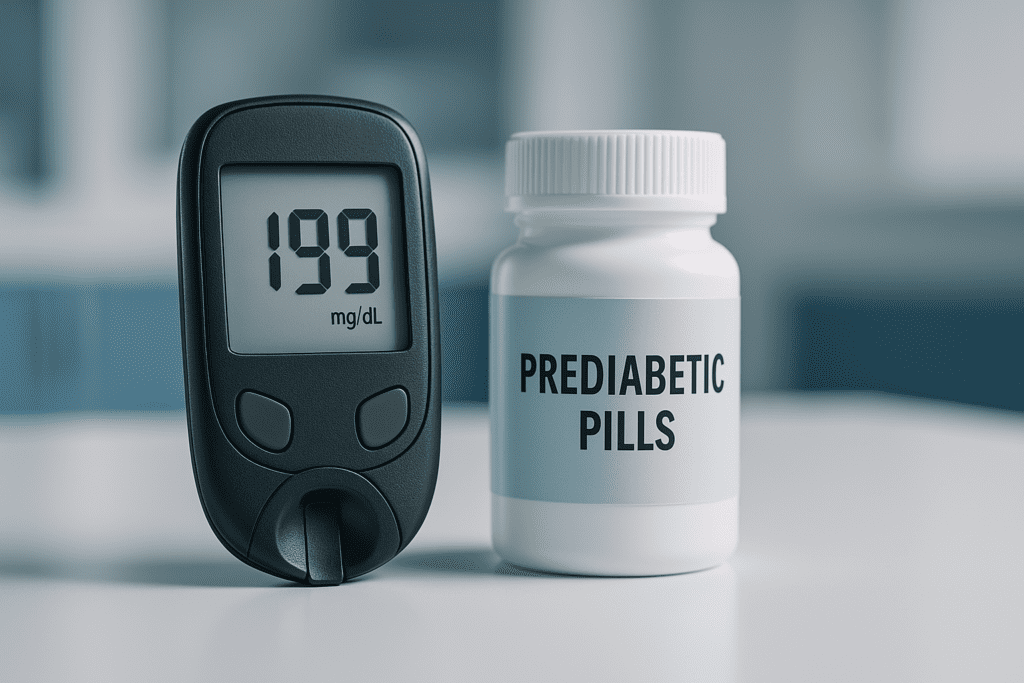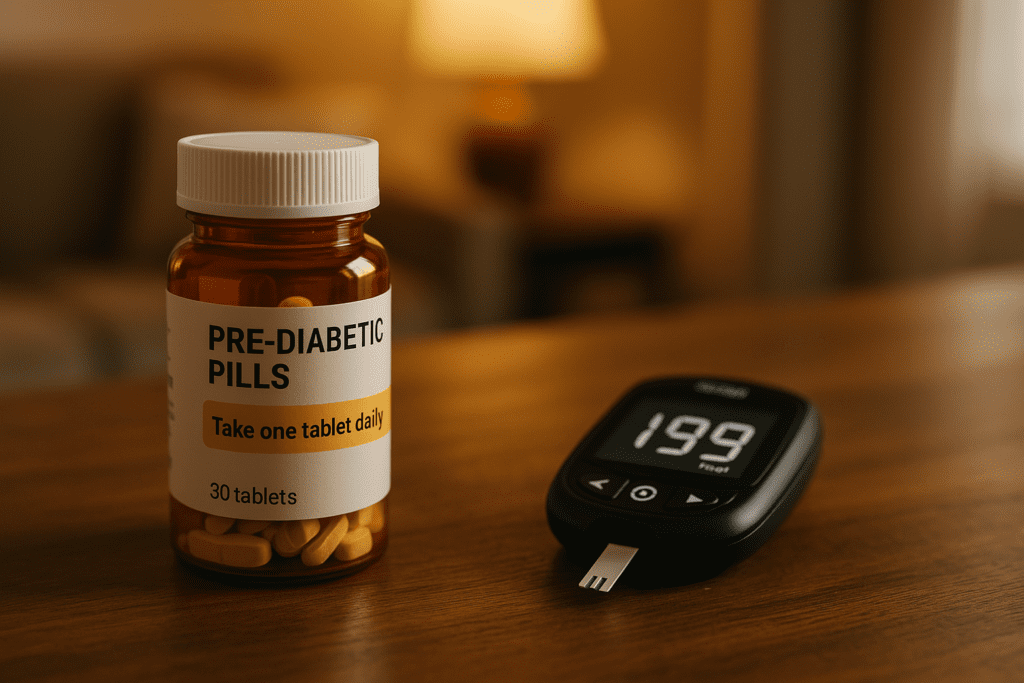Understanding Prediabetes and the Significance of a 199 Blood Sugar Level
Prediabetes represents a critical window of opportunity in metabolic health. It is a condition in which blood sugar levels are elevated beyond the normal range but not high enough to meet the diagnostic threshold for type 2 diabetes. According to the American Diabetes Association (ADA), a fasting blood sugar between 100 and 125 mg/dL or an oral glucose tolerance test (OGTT) result between 140 and 199 mg/dL qualifies as prediabetes. A 199 blood sugar level, especially when measured after a glucose challenge, is at the very edge of the prediabetic range and considered a significant red flag. It signals an urgent need for medical attention, lifestyle changes, and potentially early pharmacological intervention.
You may also like: Breakthroughs in Current Diabetes Research: What the Latest Studies Reveal About Treatment and Prevention
The medical community has long debated the optimal timing for introducing medication in individuals with prediabetes. Traditionally, lifestyle interventions such as dietary changes, increased physical activity, and weight management have been the first line of defense. However, with the growing prevalence of prediabetes, especially among younger adults and adolescents, there is renewed interest in the role of pre diabetic pills and other pharmacologic treatments as early intervention strategies. The question is no longer whether intervention is needed, but rather what form that intervention should take.
How Common Is Prediabetes and Why Early Intervention Matters
Recent estimates suggest that more than one in three adults in the United States has prediabetes, with many remaining undiagnosed. The prevalence is particularly alarming because of its association with a higher risk of developing type 2 diabetes, cardiovascular disease, and kidney complications. The high incidence of prediabetes underscores the importance of early diagnosis and timely treatment. Understanding how common prediabetes is helps explain the urgency in developing standardized treatment protocols, including both lifestyle and pharmacological options.
Prediabetes is often a silent condition, meaning individuals can live for years without symptoms while their blood glucose gradually worsens. This asymptomatic nature is dangerous, especially when a 199 blood sugar level is detected—an indicator that one may be on the brink of crossing into type 2 diabetes. With such concerning prediabetes numbers, early intervention becomes not just advisable but essential. Introducing prediabetes medication in select patients could serve as a bridge to more lasting lifestyle changes, particularly for those who struggle to make such changes immediately.

What Are Pre Diabetic Pills and How Do They Work?
The term “pre diabetic pills” broadly refers to medications used off-label or in emerging clinical protocols to delay or prevent the onset of type 2 diabetes in individuals with prediabetes. These drugs for prediabetes include medications that improve insulin sensitivity, reduce hepatic glucose production, and slow carbohydrate absorption. While there is no FDA-approved medication specifically labeled for prediabetes, several options have been studied for their preventative benefits.
Metformin is the most commonly prescribed prediabetes medicine, often recommended when lifestyle modifications alone are insufficient. It has a long-standing safety profile and works by decreasing hepatic glucose production and increasing peripheral glucose uptake. Other pre diabetes meds under investigation include GLP-1 receptor agonists, which have shown promise in reducing appetite, promoting weight loss, and improving glycemic control. SGLT2 inhibitors, though primarily used in diabetes management, are also being evaluated for their potential in pre diabetes drug therapy.
Some practitioners also explore the use of pills for prediabetes in patients who exhibit rapid deterioration of glycemic control or who present with a 199 blood sugar level repeatedly. In such cases, pre diabetes medication is seen as a preventive, not curative, measure—a tool to slow the trajectory toward full-blown diabetes while other interventions are reinforced.
Evaluating the Best Medication for Prediabetes: What Does the Science Say?
Scientific research on prediabetes medication continues to evolve, with new findings shedding light on efficacy, safety, and long-term outcomes. Several large-scale trials, including the Diabetes Prevention Program (DPP) study, have demonstrated that metformin reduces the risk of developing type 2 diabetes by approximately 31% in individuals with prediabetes. This makes it a front-runner for the best medication for prediabetes, especially in those under age 60, with a BMI over 35, or women with a history of gestational diabetes.
However, metformin is not the only option. Newer agents such as GLP-1 receptor agonists have garnered attention due to their multifaceted benefits, including cardiovascular protection and weight loss. These drugs for prediabetes offer compelling advantages, particularly in patients with additional risk factors like obesity or family history of heart disease. While cost and accessibility remain barriers, their potential as a long-term intervention is supported by a growing body of clinical data.
Not all patients with a high prediabetes number, such as a 199 blood sugar level, are ideal candidates for medication. A careful risk-benefit analysis is essential. In some cases, the side effects, costs, and patient adherence issues may outweigh the benefits of pharmacologic therapy. Nonetheless, for high-risk individuals, pre diabetes meds can be an essential part of a multi-pronged prevention strategy.
Lifestyle Changes vs. Pre Diabetes Meds: Which Comes First?
While the appeal of prediabetes meds is growing, especially among patients seeking quick solutions, healthcare professionals overwhelmingly agree that lifestyle modification remains the cornerstone of prediabetes management. Diet, exercise, sleep hygiene, and stress reduction have all been shown to improve insulin sensitivity and reduce blood sugar levels. Yet, the reality is that implementing and maintaining these changes can be incredibly challenging, particularly for individuals juggling work, family, and other responsibilities.
In this context, prediabetes medication can serve as a valuable adjunct. For patients who present with a 199 blood sugar level and feel overwhelmed by lifestyle demands, medication may provide the metabolic stabilization needed to make gradual, sustainable changes. Rather than viewing pre diabetic pills as a replacement for lifestyle efforts, they should be considered complementary. When used in tandem with evidence-based lifestyle strategies, pre diabetes drugs can significantly enhance outcomes and delay or prevent progression to diabetes.
Emerging studies are also evaluating the timing of medication initiation. Some evidence suggests that starting prediabetes meds earlier rather than later may lead to better glycemic outcomes, especially in individuals with rapid metabolic deterioration. This shifts the paradigm from reactive to proactive care, aligning with broader goals in preventive medicine.

The Role of Monitoring and Prediabetes Numbers in Treatment Decisions
Monitoring plays a central role in managing prediabetes effectively. Healthcare providers rely on a range of diagnostic markers, including fasting glucose, hemoglobin A1c, and OGTT results, to evaluate disease progression and tailor treatment plans. A 199 blood sugar level, often identified through the OGTT, represents a threshold of concern and necessitates a reassessment of the patient’s current management plan.
Tracking prediabetes numbers over time helps determine the urgency of intervention and whether prediabetes meds are warranted. For example, a patient whose blood sugar has steadily climbed from 110 to 140 mg/dL fasting may be nearing a tipping point, especially if lifestyle interventions have stalled. In such cases, pre diabetic pills may provide a buffer, allowing time for lifestyle changes to take root.
Self-monitoring at home is becoming increasingly common, thanks to advances in glucose-monitoring technology. Devices now offer more accurate readings and can be synced with mobile apps, enabling patients to understand their glucose patterns better. This empowers patients to take ownership of their health and facilitates early intervention. Recognizing rising trends in prediabetes numbers can prompt timely adjustments in medication or behavior, potentially staving off progression.
Understanding the Risks, Side Effects, and Limitations of Prediabetes Meds
Like all medications, prediabetes drugs come with their own set of risks and limitations. While metformin is generally well-tolerated, it may cause gastrointestinal discomfort, vitamin B12 deficiency, or, in rare cases, lactic acidosis. GLP-1 receptor agonists may lead to nausea, vomiting, or pancreatitis in a small percentage of users. The side effect profile of SGLT2 inhibitors includes increased risk of urinary tract infections and dehydration.
These risks must be carefully weighed against the potential benefits, particularly in individuals with a 199 blood sugar level who are teetering on the edge of diabetes. For some, the benefits of preventing diabetes-related complications may far outweigh the discomfort of mild side effects. However, for others, especially those who are otherwise healthy and motivated to pursue lifestyle changes, the drawbacks of prediabetes meds may tip the scales in favor of non-pharmacologic approaches.
Moreover, the long-term use of these medications in individuals without diabetes remains under-researched. Most trials follow patients for three to five years, leaving questions about the sustainability and safety of pre diabetic pills over decades. Until more data are available, clinicians must adopt a personalized, evidence-based approach to prescribing prediabetes medication, taking into account individual risk profiles, preferences, and overall health status.
Emerging Innovations in Prediabetes Treatment and Prevention
Medical research continues to uncover new pathways and potential therapies for managing prediabetes more effectively. In addition to existing prediabetes medication options, researchers are exploring the role of gut microbiota, inflammatory markers, and genetic predisposition in metabolic regulation. Precision medicine—tailoring interventions based on genetic, environmental, and lifestyle factors—could revolutionize the way we prescribe pre diabetes meds in the future.
Artificial intelligence and machine learning are also being integrated into prediabetes care. Algorithms can analyze large datasets to predict who is most likely to benefit from certain interventions, whether pharmacologic or behavioral. These tools could guide clinicians in choosing the best medication for prediabetes based on individual patient profiles, thereby improving outcomes and reducing trial-and-error approaches.
There is also growing interest in nutraceuticals and plant-based compounds with potential glucose-lowering effects. While not classified as formal drugs for prediabetes, substances like berberine, curcumin, and inositol are being studied for their ability to improve insulin sensitivity. Though promising, these alternatives require more rigorous clinical validation before they can be recommended alongside or in place of traditional pre diabetes drugs.
Are Pre Diabetic Pills the Right Choice for You? Key Considerations
The decision to start prediabetes meds should never be taken lightly. It requires a comprehensive evaluation of medical history, lifestyle, risk factors, and patient preferences. For individuals with a 199 blood sugar level and other risk enhancers—such as obesity, sedentary lifestyle, or a strong family history—pre diabetic pills may offer a timely intervention that shifts the trajectory of their health.
However, medication is not a silver bullet. It must be accompanied by consistent lifestyle changes and regular medical follow-up to be truly effective. Moreover, the psychological aspect of taking a pill for a condition that is not yet diabetes can be both motivating and daunting. For some, it represents empowerment; for others, it may trigger anxiety or resistance. Open communication between patient and provider is essential in navigating these complex emotional landscapes.
Ultimately, the goal is not just to manage prediabetes numbers but to transform long-term health outcomes. This requires a multi-disciplinary approach involving primary care physicians, endocrinologists, nutritionists, and behavioral therapists. When used thoughtfully and strategically, prediabetes medicine can be a powerful tool in achieving this vision.

Frequently Asked Questions (FAQ): New Insights into Prediabetes Treatment and Early Intervention
What should I consider before starting pre diabetic pills if my blood sugar is 199?
If your blood sugar level is 199, especially during an oral glucose tolerance test, you’re at a pivotal threshold for developing type 2 diabetes. Before initiating pre diabetic pills, it’s important to undergo a comprehensive medical evaluation that includes metabolic profiling, assessment of cardiovascular risk, and lifestyle analysis. These pills can be highly effective, but they work best when combined with behavioral changes and ongoing support. It’s also essential to ask your provider about alternative options and whether your current prediabetes numbers suggest rapid progression or stable trends. For individuals with fluctuating or borderline readings, prediabetes medication may not be the immediate choice, but rather a strategic fallback if lifestyle efforts don’t yield significant improvements.
How do psychological and emotional factors influence the decision to take prediabetes medication?
Mental health plays a surprisingly large role in how patients respond to a diagnosis of prediabetes and their willingness to adopt treatment strategies. The decision to start pre diabetes medication can be emotionally charged, often triggering feelings of failure or fear. However, many find that starting pre diabetes meds actually enhances their motivation by giving them a sense of control and direction. Providers should assess not only clinical indicators but also a patient’s emotional readiness and capacity to adhere to a treatment plan. Patients with elevated stress or depression may benefit from an integrated care approach that combines pills for prediabetes with behavioral therapy and support groups.
Can pre diabetic medicine reverse prediabetes entirely, or is it only a delay mechanism?
Pre diabetic medicine is designed primarily to delay or prevent the progression to type 2 diabetes, but some individuals have achieved remission of prediabetes while on medication, especially when lifestyle factors improve concurrently. However, relying on drugs for prediabetes alone without addressing underlying behaviors such as diet, sleep, and exercise rarely leads to lasting reversal. It’s also important to note that even if prediabetes numbers return to normal, long-term monitoring is still required. Sustained remission is more likely when pre diabetes meds are used as part of a comprehensive intervention plan tailored to the individual. Ongoing research continues to explore whether early, aggressive intervention with newer prediabetes meds may offer greater potential for true reversal.
Are there lifestyle changes that can enhance the effects of prediabetes meds?
Yes, several targeted lifestyle changes can significantly amplify the benefits of prediabetes medication. For instance, increasing soluble fiber intake and incorporating low-glycemic foods may improve how the body responds to insulin, which enhances the efficacy of pre diabetes drugs. Additionally, resistance training has been shown to improve glucose disposal independent of weight loss, making it a powerful complement to prediabetes medicine. Sleep optimization, often overlooked, can regulate cortisol and insulin levels, further supporting the medication’s effects. Combining these interventions often produces synergistic benefits that cannot be achieved through pills alone.
How do socioeconomic factors affect access to the best medication for prediabetes?
Access to the best medication for prediabetes is not always equitable. Patients in lower socioeconomic brackets may face challenges including cost, transportation to appointments, lack of insurance, or limited availability of certain drugs for prediabetes in local pharmacies. Even basic pre diabetes meds like metformin may be inconsistently available in some regions, or patients may face co-pays that dissuade long-term adherence. Moreover, newer medications such as GLP-1 receptor agonists may be entirely out of reach due to high out-of-pocket costs. These disparities highlight the importance of systemic solutions, such as public health initiatives and sliding-scale clinics, to ensure that access to effective prediabetes medication isn’t limited by economic barriers.
How does a 199 blood sugar level affect long-term cardiovascular risk, even before diabetes is diagnosed?
A 199 blood sugar level, although technically below the threshold for diabetes, is strongly associated with increased cardiovascular risk. Elevated glucose levels contribute to endothelial dysfunction, oxidative stress, and low-grade inflammation—factors that accelerate atherosclerosis. Even before a formal diabetes diagnosis, patients with high prediabetes numbers show elevated triglycerides, increased blood pressure, and insulin resistance, all of which raise the risk of heart attack and stroke. Incorporating pre diabetes drug therapy early may help mitigate these risks, especially when paired with interventions targeting lipid profiles and blood pressure. Understanding this broader health context is crucial when evaluating the necessity and timing of pre diabetic pills.
What are the risks of stopping prediabetes meds after initial improvement?
While some individuals may wish to stop prediabetes meds after seeing improvements in their prediabetes numbers, doing so can be risky without proper supervision. Abrupt discontinuation may lead to rebound hyperglycemia or loss of glycemic control if the underlying causes haven’t been adequately addressed. Moreover, the benefits of prediabetes medicine often accumulate over time and can wane rapidly if treatment is stopped too soon. A structured tapering plan, guided by a healthcare provider, may allow for a gradual transition to lifestyle-only management. Patients must also be vigilant about retesting to ensure that a lowered prediabetes number doesn’t climb back up once medication is withdrawn.
Are there any new or emerging pre diabetes meds that show promise beyond metformin?
Yes, several innovative therapies are currently in development or undergoing clinical trials that go beyond the mechanisms of metformin. Some of the newer pre diabetes meds target hormonal pathways such as GIP and GLP-1 simultaneously, offering potential advantages in weight regulation and metabolic efficiency. Others focus on modulating the gut microbiome to improve insulin sensitivity and reduce systemic inflammation. Research into SGLT2 inhibitors as off-label prediabetes medication is ongoing, with early results suggesting benefits in specific subgroups. While these therapies are not yet standard, they represent the future landscape of drugs for prediabetes and may eventually expand the therapeutic toolkit significantly.
How common is prediabetes among children and adolescents, and does treatment differ?
Although prediabetes was once considered a condition of adulthood, rates among children and adolescents have been steadily climbing, particularly among those with obesity or a family history of diabetes. The question of how common is prediabetes in younger populations has become central to public health discussions. Treatment in this demographic often emphasizes lifestyle modification more strongly than pharmacologic approaches due to limited data on the long-term effects of prediabetes medication in children. However, in cases of rapid metabolic decline or extreme obesity, healthcare providers may cautiously consider initiating pre diabetes drugs like metformin under strict monitoring. School-based interventions, family counseling, and pediatric endocrinologist input are essential in ensuring that treatment aligns with developmental needs and long-term safety.
How can patients track progress beyond just checking their prediabetes number?
Tracking progress in prediabetes management involves much more than simply monitoring a single prediabetes number. Patients should also observe trends in fasting glucose, HbA1c levels, waist circumference, and even quality-of-life metrics like energy levels or sleep patterns. Many mobile health apps and wearable devices now offer integration with glucose monitors, allowing for real-time feedback on how food, activity, and stress impact glycemic variability. When using pre diabetic pills, this broader perspective can help identify whether the medication is having its intended effect or if adjustments are needed. Patients are encouraged to collaborate with their healthcare team to interpret these patterns and adapt their treatment strategy accordingly, rather than relying solely on static lab results.
Conclusion: Weighing the Role of Prediabetes Medication at the Edge of Diagnosis
In the landscape of metabolic health, the detection of a 199 blood sugar level stands as both a warning and an opportunity. It signals that the time for action is now. For many, lifestyle changes remain the cornerstone of prediabetes management. But for others, especially those at high risk of progression, the addition of pre diabetic pills may offer a critical buffer, buying time and providing biochemical support as deeper behavioral changes take root.
The latest research on drugs for prediabetes suggests that strategic pharmacologic intervention, when combined with individualized care, can significantly reduce the likelihood of developing type 2 diabetes. While no single option represents a universal solution, the evolving landscape of pre diabetes medication offers hope. Whether you’re considering pills for prediabetes or simply seeking to understand how common is prediabetes in today’s world, one thing is clear: informed, proactive care makes all the difference.
As science continues to evolve, so too does our understanding of prediabetes management. The key lies in leveraging both old wisdom and new innovation—combining diet, movement, technology, and the best medication for prediabetes—to create sustainable health outcomes. With expert guidance, timely monitoring, and the right tools, patients can navigate the narrow corridor between health and disease with greater confidence and control.
insulin resistance treatment, early diabetes prevention, glucose tolerance test insights, metabolic syndrome management, lifestyle changes for blood sugar, nutritional therapy for insulin health, personalized diabetes risk assessment, obesity and prediabetes link, cardiovascular risk in metabolic disorders, non-insulin diabetes therapy, glycemic control strategies, innovative diabetes research, metabolic health trends, pharmacologic interventions for prediabetes, health tech for blood sugar tracking, hormonal regulation and glucose, gut microbiome and blood sugar, long-term diabetes prevention plans, digital tools for prediabetes care, health disparities in diabetes treatment
Further Reading:
Prediabetes Is on the Rise—But It Can Be Reversed
Pre-Diabetes, Metabolic Syndrome, and Cardiovascular Risk
Prediabetes: A window of opportunity
Disclaimer
The information contained in this article is provided for general informational purposes only and is not intended to serve as medical, legal, or professional advice. While MedNewsPedia strives to present accurate, up-to-date, and reliable content, no warranty or guarantee, expressed or implied, is made regarding the completeness, accuracy, or adequacy of the information provided. Readers are strongly advised to seek the guidance of a qualified healthcare provider or other relevant professionals before acting on any information contained in this article. MedNewsPedia, its authors, editors, and contributors expressly disclaim any liability for any damages, losses, or consequences arising directly or indirectly from the use, interpretation, or reliance on any information presented herein. The views and opinions expressed in this article are those of the author(s) and do not necessarily reflect the official policies or positions of MedNewsPedia.


